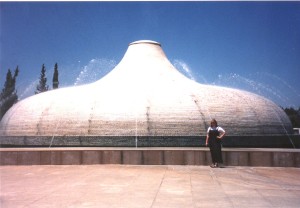New Scientific Techniques to Measure Scroll Deterioration, Biblical Archaeology Review, Jul-Aug 1981.

Shrine of the Book. By Xavier Gillet, Bordeaux, France (xavier33300 on flickr) – Musée de Jérusalem – Israël, CC BY-SA 2.0, https://commons.wikimedia.org/w/index.php?curid=35329671
Scientists at the Weizmann Institute in Rehovot, Israel have recently found ways to measure scientifically the amount of deterioration in the Dead Sea Scrolls. These measurements will be used to monitor the scrolls at the Israel Museum to insure that me further deterioration of the scrolls occurs.
The scrolls are written primarily on parchment prepared from animal skins—mainly sheep and goat. Parchment contains collagen which when exposed to excess heat or moisture tuns to gelatin.
Using an X-ray diffraction technique, Weizmann Institute scientists have developed a method for measuring semi-quantitatively the relative proportions of collagen and gelatin in parchment. The technique is, fortunately, nondestructive. Testing has no effect on the parchment being examined. The higher the ratio of gelatin, the greater the deterioration.
Scroll samples have been placed at various locations within the museum’s scroll area. Periodically these sample fragments will be examined for change in the collagen/gelatin ratio, which would indicate an unsafe environment for the scrolls.
In their study of the scrolls, the Weizman scientists found, not unexpectedly, that the darker borders of the scrolls had deteriorated the most and that the inner sheets were better preserved than the outer sheets. This suggests to the scientists that an external environmental agent, probably water, was responsible for the deterioration.
Read the rest of New Scientific Techniques to Measure Scroll Deterioration in the online Biblical Archaeology Society Library (sidebar to “Saving the Dead Sea Scrolls for the Next 2000 Years”).



